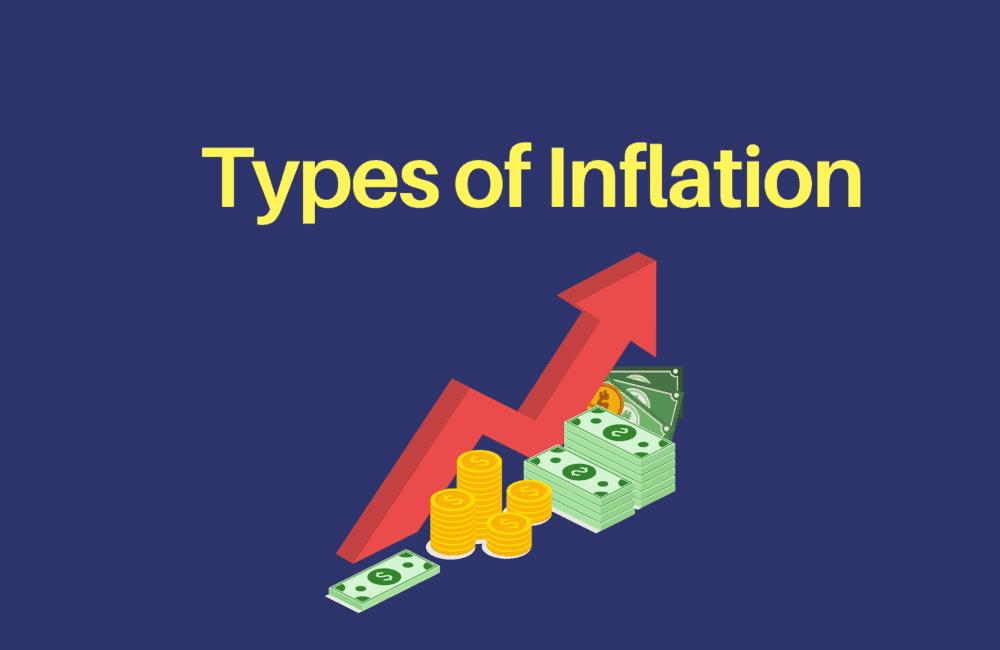Inflation – Introduction
A rise in prices continuously can be scary as the cost of living keeps on increasing. But why do the prices keep on rising at particular intervals of time? This can all be owed to one term that causes dread among the nations, also known as Inflation. Historically, inflation types have caused a wreck among nations that have suffered from higher rates of inflation. Although India has intolerance for the higher rate of inflation, the track record suggests that India hasn’t experienced hyperinflation since 1801. Here we explained different types of inflation.
What Is Inflation?
Inflation means a rise in the price of goods and services due to an underlying rise in the costs of processing those goods. In simple terms, if a small pack of dairy milk chocolate was available for Rs. 2 a piece a decade ago, due to inflation types the same pack of chocolate costs you Rs. 10 a piece. The rising prices due to types also indicate that your purchasing power for the same goods will decrease. Moderate levels of inflation can stimulate economic growth; however, a higher rate of inflation is considered to be a slow poison that can quickly wipe off your entire economy.
Recommended: Best Passive Income Ideas That Will Earn You Money 24/7
Types Of Inflation
Inflation comes in different shapes and forms. The various inflation types are listed below:
1. Demand-pull Inflation
Demand-pull inflation type is when demand for goods and services is higher compared to its supply which leads to upward pressure on the prices of the goods and services. In other words, it is also known as ‘too many dollars that are chasing too few goods’. The ever-increasing prices and shortage of goods can result in the rise of prices. During such inflation, the sellers will try to increase their supply to close the gap and bring the prices back to a moderate level.
2. Cost-push Inflation
Cost-push inflation type is when prices rise due to an underlying increase in the cost of raw materials or wages. If the cost of production increases, the rate of supply will decrease in the economy. With the rising demand for the goods, the suppliers are then forced to pass on the rise in underlying costs to the consumers which leads to cost-pull inflation. This phenomenon occurs when there is a monopolistic product in the market. The demand for a monopolistic product never reduces even with the rise in costs which leads cost-push inflation types.
3. Built-in Inflation
Built-in inflation type is when people in the present expect that inflation in the future will rise at a steady rate. An increase in prices also leads to greater demand for an increase in wages so that the people can afford the increase in the standard of living. Hence, the wage workers start demanding an increase in wages which in turn increases the cost of production. The rising cost of production coupled with an increase in demand, in turn, leads these inflation types. This vicious circle keeps on continuing to no end.
Recommended: Best Ways to Earn Money Online
Types Of Inflation Defined By Rate Of Increase
Different inflation rates also characterize inflation types which are given in detail below:
1. Creeping Inflation
Creeping inflation type is when price increases at a slower pace. For example, an inflation rate that is slowly rising from 2% to 3% or 4% in a year is known as creeping inflation. This type of inflation is hard to notice due to its slow movements but can become a problem over the longer run. Usually, creeping inflation remains at a level of 1% to 4%. The United Kingdom and Canada are known for having creeping inflation types.
2. Walking Inflation
Walking inflation is when price increases are moderate over some time and the rate of inflation remains below 10%. Although walking inflation is not considered to be problematic, any inflation rate above 4% is quite concerning. Central Banks start tightening their liquidity measures once inflation crosses 4%. Usually, walking inflation remains at a level of 2% to 10%. Indian and the United States are known for having walking inflation.
3. Running Inflation
Running inflation is when there is a significant increase in the price levels. When the prices keep increasing rapidly it is usually considered to be a red flag. The country with a higher rate of inflation has to bear additional expenses at the cost of its economic growth. Usually, running inflation remains at a level of 10% to 20%. Turkey and Ethiopia are known for having running inflation.
4. Galloping Inflation
Galloping inflation is when prices are rapidly increasing over some time. Such rapid swings in price levels are often hard to control over the long term and detrimental to economic growth. Usually, running inflation remains at a level of 20% to 1000%. Galloping inflation is one level below the hyperinflation levels. Zimbabwe and Lebanon are known for having galloping inflation.
5. Hyperinflation
A hyperinflation is also an extreme form of inflation that is very difficult to control beyond a point in time. The price changes under hyperinflation are so rapid that it is hard to keep track of such changes. The rapid price changes can be a daily occurrence that will result in the deterioration of the overall value of money. Usually, running inflation is above 1000%. Venezuela is popular for its hyperinflation levels which are at 2720%.
Core Inflation
Core inflation is a measure that eliminates the temporary volatility in prices of certain commodities like foods, energy drinks, etc. The Consumer Price Index (CPI) calculated in India represents the core inflation index which excludes the goods and commodities with extreme volatility. Temporary price swings can affect the overall inflation levels and highlight a wrong picture as a result the core inflation numbers do not consider the temporary changes in the price.
Final Thoughts
Inflation types can be detrimental to the health of any economy if it is not kept under control. The Central Banks use various liquidity measures through the monetary policy that helps in keeping inflation under check. Inflation types rate remaining at a steady level through various measures can flourish your economy.
Frequently Asked Questions
What Is Inflation?
It is defined as the declining value/power of the currency of the country over time.
What Is Deflation?
It is defined as the increasing value/power of the currency of the country over time.
Is Inflation Bad?
Only if it is controlled. Too much or too little inflation is also harmful for the country.
What Are Inflation Effects?
If it causes the value of a country’s currency to decline, then it can be beneficial for the exporters.
What Are The Types Of Inflation?
Majorly three types – demand-pull, cost-push and built-in.



